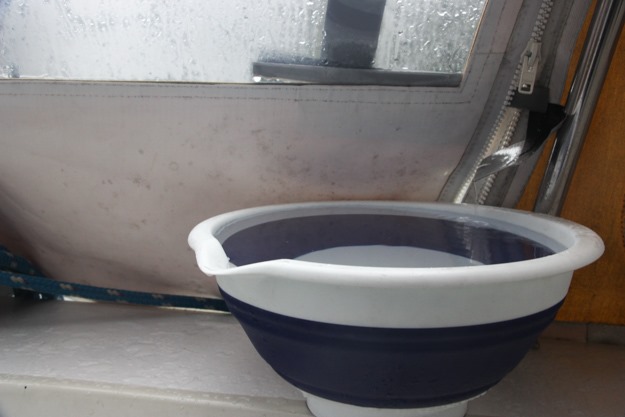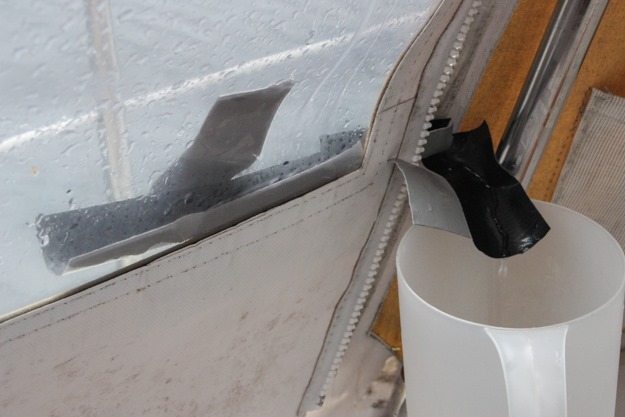While cruising for extended periods in remote areas, refilling our water tanks is often the limiting factor in how long we can go between marinas. We’re a “water light” boat, with only a 29 gallon tank plus about 12 gallons in jugs on deck. This easily lasts us 1 1/2 to 2 weeks on our water-light budget (using about 3-4 gallons per day).
Our 41 gallons is far less than most long-distance cruising boats carry though – on the order of 75 to 150 gallons. Our boat was originally equipped with 75 gallon capacity, and I thought I’d have to add back one of the removed water tanks, but we’ve found it not to be necessary. More water adds a lot of weight, takes away storage space, and decreases sailing performance – a priority for us.
But sometimes we want to go a bit longer between marinas, such as when cruising from the North Coast of BC to the south of Haida Gwaii, areas with no convenient marinas. Some boats buy expensive watermakers which are infamous for being a maintenance headache. Here in the Pacific Northwest though we have a free, frequent source of pure water – rain!
For a while I’ve thought it’d be great to be able to catch some of it, but it’s not as simple as it seems. The main problem is catching a lot of it, and getting clean water that is free of salt (our decks are usually covered in salt) and other contaminants.
During three days this May holed up in Clark Cove while a gale blew through, bringing near-constant rain, I tried out a few improvised ideas, using only what we already had on the boat.

Buckets and Bowls
The easiest, most obvious method is to just put buckets or bowls from the galley out on deck. This is easy but also slow – in 1 hour, a large bowl gathered only about 1 cup of water. You also need to secure the bowls / buckets so they don’t blow away in the wind (gales bring a lot of rain *and* a lot of wind).
I prefer bowls from the galley because they’re clean and we can drink the harvested water. Our buckets have been used for washing the boat and pumping the bilge, and may have oily residues – so unless well cleaned, we use bucket-collected water just for hand washing or the pre-wash phase of dish washing.

To improve bucket / bowl collection, I looked around the deck for places where water is dripping, finding the drips with the fastest and most consistent rate. Under the boom and mainsail is a good one, and under our foresail furler turned out to be one of the best. Some water drips down the furled sail and then drips from the furler drum, which I placed a bucket under (and tied it with a string so it wouldn’t blow away).
Tarps
Setting up a tarp is another popular and obvious approach, but I found it to be rather difficult to secure the tarp in even 5 knot winds – the 15-20 knot winds that came later would’ve rendered the tarp a major nuisance.
The tarp could work well with low wind and better tools – I believe other boaters have had success with it by running a pvc pipe or rope along the middle of the tarp to create a crease, and then tightly tensioning all the corners (to lifelines, the boom, or rigging).
Duct Tape Funnel System
Seeing a stream of water running down the window of our full enclosure, I got the idea to make a gutter or aquifer to divert this into a container. It was much easier than expected and took only 5 minutes to setup.

The reason I used Duct Tape is it sticks even to wet plastic, it’s water resistant (won’t get soggy), and can be bent and shaped to make a gutter. The trick is to look for a spot on your dodger or bimini where the water is running down in a rivulet – creases in the plastic tend to create hotspots of water run-off.
Deck Run-off
We didn’t try this, but I’ve heard collecting the deck run-off through a deck scupper is the most productive method. The idea is to disconnect a deck scupper hose below-decks and redirect the water run-off to a container.
My concern with this is our decks are usually really salty and dirty while cruising. They say to just wait till rainwater has flushed this away, but I’m not certain how to tell when that’s happened, and I think encrusted salt and sand on our decks gradually washes through the scuppers for many hours.
Results
The forestay / furler bucket was the most productive, filling a 2 1/2 gallon bucket in 2 – 3 hours (about 1 gallon/hour). However this is the saltiest area of the boat, so the first bucket collected we used only for cleaning water (even though we couldn’t detect any salt). Subsequent buckets we used for drinking water, after checking that it tasted clean and fresh.
The duct tape gutter on our full enclosure window was the second most productive, producing about 1/2 gallon per hour. It was also the most convenient because we could monitor it from within the boat, by looking through the cockpit window, and could change the pitcher out without donning rain gear.
In one day we collected about 2 gallons of drinking water and 2 gallons of cleaning water. Overnight and the next day we collected at least 7 gallons of additional drinking water. Our tanks and jugs were now all full, and we had to stop collecting rainwater. This rain storm in Clark Cove was serious even by Seattle standards, raining non-stop for 3 days.
Benefits – Why Bother?
There are certainly more efficient ideas we could come up with, and I know some cruisers have designed far better systems. But this was a fun, easy experiment for a rainy day using the tools we already had onboard.
Rain water catchment won’t provide enough water to make a huge difference in how long you can be off the grid, but it does make a bit of difference if you’re a water-light boat. I look at it as bonus water – allowing us to not have to worry as much about running out, or go a few more days before visiting a marina.
In a day, we harvested more water than we use in a day, with about 30-45 minutes of work. So the day was a net neutral (or slight positive) on our resources, meaning our day hiding from the gale didn’t deduct anything from our resources and we didn’t lose a day of between-marina time. A cruising boat is like a bank of constantly depleting resources (water, fuel, food, electricity), replenished in civilization. The more of those you can self generate, the longer you can cruise where you want to before being forced to make a marina detour.
Cruising in remote areas surely forces you to confront your fears. Natalie’s fear is running out of food (and we’re doing very well here, stocked with enough food to last 2-3 months – but we run out of fresh veg, fruit and meat in about 2 weeks). My fear is running out of any of the other resources the boat requires to sustain us – water, electricity, and diesel.
Electricity is pretty much self generating by our solar, and diesel use is minimized by sailing a lot. Water is pretty hard to self generate though unless you have a desalinating water maker (and that uses a lot of electricity, which may mean more solar panels needed). Rainwater catchment adds one more tool to our arsenal towards extended self-sufficiency.

I enjoyed reading how you tinkered with your ideas. I agree, sometimes there IS fun to be had in finding a solution. Cheers!
Looks like you’ve been through the same thought process as myself, though with two tanks in the boat (80 gallons total) it was never quite as acute as your own water needs. One thing to keep in mind is the presence of fluorocarbon treatments running off of your canvas (assuming sunbrella sun cover on your RF headsail or other locations). It’s showing up in increasing accumulations in humans as it bio accumulates and is suspected of causing nasty things like liver damage and birth defects. I don’t know how effectively it can be filtered, but at the very least would be sure to run it through a fresh carbon filter for any water you might drink.
Interesting, hadn’t considered that. Sounds worth looking into. In a couple Google searches I couldn’t easily find out whether uv treatment actually has florocarbons, or a conclusive medical study showing health impacts of it.
However I would think the concentrations coming off a sail in a few hours of rain water are so minute that it’s on a similar order as homeopathic medicine.
Research PFAs or Forever Chemicals. They are not friendly to the human body. I have no idea of the sunbrella question,
I read that even a Brita filter will remove them though. A better water filter system should be a great addition prior to drinking any rain water. One of the channels, the ones that lived in a van prior to going nautical – perhaps – cannot remember their names or channel off hand – had an excellent post on a two part water filter system they have used for potable drinking water since the days in the van.
Gone with the Wynns, I believe.